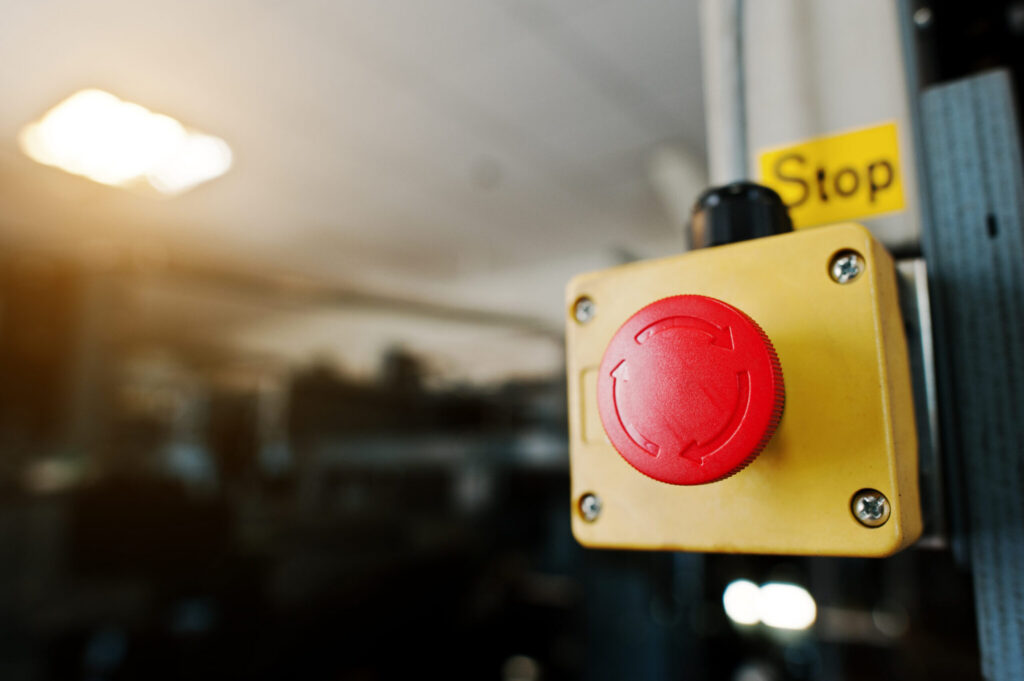
The Estonian Working Life Portal published an article on its website about the emergency stop button. The article first describes the situation of a worker on a woodworking line, where neither he nor his co-worker can stop the line in case of an emergency because the emergency stop button is inaccessible in an emergency situation. Rein Reisberg, Work Environment Consultant, then answers the question of the button’s location requirements.
Unfortunately, there are many similar situations, and many of the stories and hazards are bound to remain hidden. In 2023, it is estimated that there were a total of 5 242 accidents at work in Estonia that resulted in more than 3 days of incapacity to work (Statistics Estonia 2024). The article described above also raised a discussion within the Revismo team. There was a discussion about workplace safety, occupational accidents and ISO 13850, which partly regulates the requirements for the emergency stop button. It should be mentioned that there are more standards concerning emergency stop.
First, we need to be clear about the fact that all industrial environments are dangerous and that no production is 100% safe. Nevertheless, employers must do their utmost to identify and mitigate the risks to workers in production and in the handling of machinery. Emergency evacuation requirements must also be familiarised and addressed.
The functions of the emergency stop button are partly governed by the international standard ISO 13850. Its full name is “ISO 13850: Safety of machinery. Safety of machinery. It defines requirements and guidelines on how the emergency stop function must be designed and implemented to ensure the safety of people. The abbreviation ISO stands for International Organization for Standardization. ISO standards are numbered with unique numbers for easy identification and reference. Each number represents a specific field or topic. 13850 is therefore simply a sequential numerical identifier that helps to distinguish one standard from another.
The requirements under the Machinery Directive are mandatory and general, for example: “Machinery must be designed so as not to present a risk to persons.” The purpose of the relevant standard is then to define the specific measures that will help to ensure that the machinery is properly designed and meets the safety requirements of the Directive. ISO standards are international guidelines and recommendations designed to help organisations and companies to harmonise and improve the quality of products, services, processes and management systems.
However, there are situations where following an ISO standard is strictly recommended:
- Safety requirements for equipment and machinery – Many parts of the safety systems of equipment and machinery are covered by ISO standards. Examples include the emergency stop buttons, safety fences, noise levels, control systems, safety distances, etc. mentioned above.
- Risk analysis and risk assessment – ISO standards provide a framework against which risks associated with equipment and machinery can be assessed. Listed here are just a few:
- ISO 12100: “Safety of machinery. 12100 – Safety of Machinery – General Principles for Design, Risk Assessment and Risk Reduction”, which deals with the safety of machinery and risk assessment of hazards.
- ISO 13849: “Safety of machinery. Safety-related parts of control systems (two parts)”, which deals with the safety of control systems related to the safety of machinery.
- ISO 14123: “Safety of machinery – Reduction of risks to health resulting from hazardous substances emitted by machinery”, which deals with the safety of machinery and the protection of workers from hazardous substances which machinery may emit during production or use.
- ISO 13855: “Safety of machinery – Positioning of protective equipment with respect to the approach speeds of parts of the human body”, which deals with the safety of machinery and the specific positioning of protective equipment to ensure safety.
- Work environment – Various ISO standards also regulate the work environment, including industrial companies, such as ISO 45001, which deals with occupational health and safety management systems, and ISO 9001, which sets requirements for quality management systems.
The topic will be summarised by Rasmus Koop, a Certified Machinery Safety Expert (CMSE®) and member of the Revismo team:
“Ensuring the safety of machinery and the working environment is the responsibility of every company. The company’s responsibility is to ensure that all machinery and equipment is a company responsibility. Even though there are many different requirements and standards and it takes time to work through them, this does not mean that there is a dangerous working environment or, in the worst case, an accident at work. Revismo has been exposed to a wide variety of ISO standards in its 11 years of operation and we would therefore like to stress the importance of ensuring a safe working environment and safe machinery in preventing accidents at work. ISO standards have a very important role to play in ensuring safety and should be seen as supporting documents rather than as annoying instructions. If the world of regulations seems too massive, it is always a good idea to bring in outside help who can easily manage it all. Revismo specialists can always be consulted on these matters.”
 Rasmus Koop is a mechanical engineer, who has a degree from Tallinn University of Technology. At Revismo, he specialises in risk analysis and the preparation of operating and maintenance manuals. Throughout his career, Rasmus has focused on ensuring production safety and improving quality in a wide range of technical processes and projects. He has completed the internationally recognised PILZ machine safety training and holds the TÜV NORD Product Safety Expert certificate, which proves his competence in machine safety and CE compliance. Rasmus’ strengths include a systematic approach and thoroughness, as well as the ability to work collaboratively with both customers and engineering teams.
Rasmus Koop is a mechanical engineer, who has a degree from Tallinn University of Technology. At Revismo, he specialises in risk analysis and the preparation of operating and maintenance manuals. Throughout his career, Rasmus has focused on ensuring production safety and improving quality in a wide range of technical processes and projects. He has completed the internationally recognised PILZ machine safety training and holds the TÜV NORD Product Safety Expert certificate, which proves his competence in machine safety and CE compliance. Rasmus’ strengths include a systematic approach and thoroughness, as well as the ability to work collaboratively with both customers and engineering teams.

